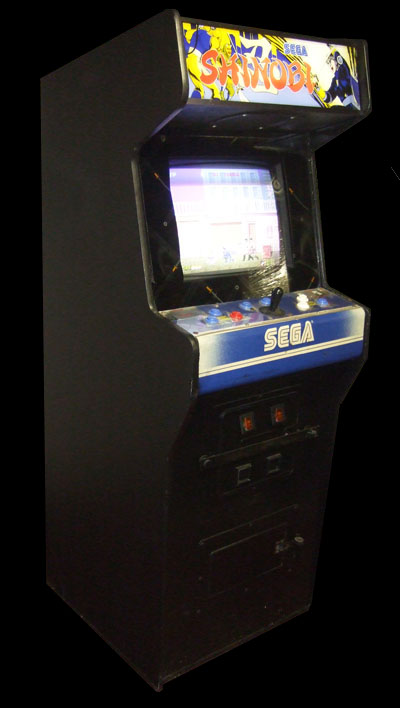
Reviewed
02.02.2016
Publisher
Sega
Developer
Team
Shinobi
Arcade
System
Sega
System 16
Origin
Japan
Available
Nov.
1987
(Japan)
1987
(USA)
Difficulty
Normal
Dimensions
2D
View
Side
Genre
Action/Platform
Player(s)
1-2
(alternating)
Display
Raster
320x224 |
| Intro |
|
> Shinobi is a side-scrolling action/platform game originally released
for the arcades in 1987. Up to two players can play with alternating
lives. It uses the Sega System 16 arcade hardware. Back in
the late 80s, it was all the rage amongst coin-op game players.
> The player controls a ninja master, Joe Shinobi Musashi, who has martial
arts and ninja magic at his disposal. A terrorist network,
the evil "Zeed", has kidnapped the children of Musashi's ninja clan, so
it's a rescue mission as well as a battle to destroy these criminals. |
| Graphics |
|
> Shinobi's backgrounds are mainly static with some animation like water
rustling at the shipyard. Of course, the characters, magic, and weapons
are animated well. Musashi ventures through various locales including
a back street, industrial port, hideout, and more.
> The character animation is noticeably better than the Master System port,
but certainly (still) shows its age. At the end of each (3-4 stage)
mission the player will go up against some mighty impressive bosses including
a giant samurai, military helicopter, masked ninja, and more. Between
missions the player competes in bonus rounds, which are a first person,
shuriken throwing, shooting gallery of enemy ninjas. |
| Control |
|
> The gameplay is classic ninja action. The player can touch most
enemies without being killed, while being hit by a weapon or physical attack
is instant death. Move with the joystick, use weapon with button
1 (shuriken, sword, nunchaku, bombs, gun), and jump with button 2.
Other moves include punch and kick (which depends on your position), and
ninja magic (ninjitsu) with button 3. There are three types of ninjitsu
(thunderstorm, tornado and doppelganger) that vary depending on the stage.
The player has a three minute time limit to complete each stage.
It's mandatory to rescue all the hostages before moving on to the next
stage. Once you lose all your lives, unlimited continues are available
until you reach the 5th mission.
> Shinobi has to be one of the first side scrolling action games which
allows the protagonist to jump up/down to different levels. Many
times Musashi will need to do this in order to save a hostage, which usually
yields some sort of power up. As for the bonus rounds, one simply
moves left and right while shooting enemies with unlimited shuriken.
An extra life is earned from a successful bonus round. |
| Sound |
|
> Even though the soundtrack is classic Z-80, it's still rather catchy
and certainly better than the SMS port (as expected). Shinobi's tunes
have an Oriental theme, which go great with the on-screen action and set
the mood quite well. The sound effects are limited but adequate.
Nothing fancy, just bleeps and blops for various weapons and cues. |
| Fun |
|
> Your task... complete 5 missions (with bonus rounds) of ninja combat.
I couldn't stop playing this game when it came out in the arcades, or once
released on the Master System. Twenty nine years later, Shinobi still
provides solid 2D side-scrolling ninja action without needing a tutorial
(like today's games). |
| Bottom Line |
| >
If you like classic arcade action games, then look to Shinobi (most likely
via emulation these days). It's easy to pick up and play, yet challenging
to master. Shinobi (still) provides hours of ninja fun, courtesy
of Sega's master programmers of the golden arcade era (1985-1995). |
| Ratings |
| Overall:
9.2 | Graphics: 9.5 | Control: 9.0 | Sound: 8.5 | Fun: 9.5 |
~
Shinobi ~
| Shinobi - Marquee |

|
| Shinobi - Cabinet |

|
|